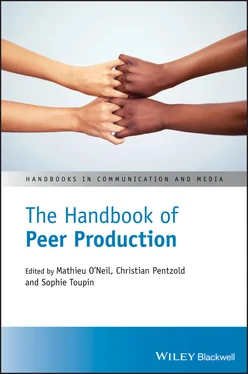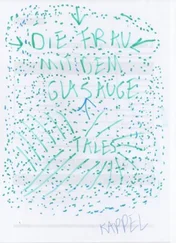Francesca Musiani
From a technical standpoint, systems based on peer design are often deemed to be superior to proprietary and more centralized systems, because they value long‐term robustness over cost‐effective commercial expedience. Yet, in several cases, peer projects are unable to compete with proprietary systems. A number of factors may be the cause of this phenomenon, including the difficulty in providing proper quality of service in the early phases of a system that relies exclusively on users’ contributions; the volunteer development model, which oftentimes lacks incentives for performing routine albeit necessary tasks; the difficulty in equaling user‐friendly, sometimes non‐technical aspects of proprietary systems, such as attractive and comfortable design; or finding a straightforward business model that can successfully be associated with decentralization. Drawing on two case studies, this chapter addresses the issue of the “gaps” in peer‐based design of the technical architecture of Internet‐based services; although net architecture will be our primary focus, we will see how dynamics of motivation/incentives to participate in peer‐based systems and their attractiveness/usability are fundamentally linked to the constraints and opportunities of different architectural designs. Indeed, the chapter shows how these gaps are grounded in a mix of technical, social, and economic factors, and contributes to explain why, while user‐controlled, peer‐based decentralized alternatives to Internet‐based services have been regularly put forward in preference to Internet giants, their developers have found it challenging to compete with proprietary market leaders.
26 Makerspaces and Peer Production: Spaces of Possibility, Tension, Post‐Automation, or Liberation?
Kat Braybrooke & Adrian Smith
Makerspaces are open community workshops for peer production which offer the technical tools and training to experiment with making, learning, and hands‐on participation around material cultures. Makerspace networks provide people with skills and access to versatile design and fabrication technologies, as well as traditional hand‐tools; and they provide social spaces that foster communities who share an open and collaborative ethos interested in the possibilities that democratized design and fabrication technologies might offer personally, socially, economically and culturally. However, as well as being spaces of creative and transformational possibility, makerspaces also experience many of the tensions of our current conjuncture. Some makerspaces have become synonymous with neoliberal business‐as‐usual, where a kind of entrepreneurial citizenship is prototyped through the exploitation of precarious labor by businesses and institutions. Peer production in makerspaces sits in tension with pressures to enclose, commodify, and compete to provide profitable inputs into global manufacturing circuits. This chapter explores the dynamics of makerspaces as spaces of possibility, tension, post‐automation, and liberation, examining in particular how institutional encounters prompt makerspaces to interpret, reinforce, and challenge prevailing socio‐technical regimes in society.
27 Peer Production and State Theory: Envisioning a Cooperative Partner State
Alex Pazaitis & Wolfgang Drechsler
This chapter theoretically examines the concept of the partner state, as a new form of symbiosis between state and civil society, based on the principles and practices of peer production. The general stance of peer production advocates is almost intrinsically anti‐state. However, state theory arguably reveals that the examination of the state and its institutions actually helps us understand the position and potentials of peer production for broader social and economic transformation. A tentative union between Hegelian and Gramscian thought delineates why and how the state can, and arguably should, embrace and support peer production. Finally, a preliminary framework for the prefigurative institutions of the partner state is offered through the analysis of the concept of open cooperativism.
Part VI Conversions: Advancing Peer Production
28 Making a Case for Peer Production: Interviews with Peter Bloom, Mariam Mecky, Ory Okolloh, Abraham Taherivand, & Stefano Zacchiroli
Peer production is first and foremost a practical affair. In these interviews, practitioners involved in setting up, developing, and maintaining diverse peer‐production projects share their experiences and insights: Peter Bloom talks about the Rhizomatica project, Mariam Mecky speaks about the endeavor to create HarassMap; Ory Okolloh reflects on Ushahidi; Abraham Taherivand discusses the role of Wikimedia, and Stefano Zacchiroli provides insights into the Debian FOSS community.
29 What’s Next? Peer Production Studies?
Mathieu O’Neil, Sophie Toupin, & Christian Pentzold
This chapter re‐examines the dual contribution of peer production to productive efficiency and social justice. We first interrogate each of these concepts’ potential for future research. Next, the chapter reflexively evaluates peer production as an object of study by mapping a network of peer‐production researchers and by considering whether a field of “peer production studies” has emerged, as well as how such a field is structured. The questions that animate this chapter are: How should we think about peer production? How are other people thinking about it? What is it good for, in analytical terms, exactly? Should peer production become a field of study?
30 Be Your Own Peer! Principles and Proposals for the Commons
Mathieu O’Neil, Sophie Toupin, & Christian Pentzold
At the heart of peer production lies the impulse to take control of one’s life and produce something independently of the authority of social and professional hierarchies. This is also a deeply moral impulse, as the fruits of one’s labor are meant to be shared with others: the commons are both the resource being produced and the means to produce it. In this way peer production challenges the dominant societal model based on the solitary consumption of perishable items which are always produced somewhere else . Peer production is therefore organically connected to issues such as sustainable development, the re‐localization of the economy, and “degrowth.” This final chapter builds on the conceptual breakthroughs discussed in the Handbook of Peer Production to reflect on the existential import of peer production as a set of alternative ethical life‐choices. It sets out to define legal, economic, and policy initiatives required to grow the commons. Readers are presented with practical suggestions to shape the future by collaborating with others to create common goods.
Part I Introduction
1 The Duality of Peer Production: Infrastructure for the Digital Commons, Free Labor for Free‐Riding Firms
Mathieu O’Neil, Sophie Toupin, and Christian Pentzold
There never was a “tragedy of the commons”: Garrett Hardin’s overgrazing farmers were victims of a tragedy of self‐management , as they failed to collectively regulate, as equals, their common pasture. When Elinor Ostrom was awarded the Nobel Prize in Economics in 2009, the immemorial notion that there are only two types of goods in the world – private and public, coordinated by markets or the state – was finally put to rest. In the most general terms, peer producers are people who create and manage common‐pool resources together. It sometimes seems as if “peer production” and “digital commons” can be used interchangeably. Digital commons are non‐rivalrous (they can be reproduced at little or no cost) and non‐excludable (no‐one can prevent others from using them, through property rights for example). So, practically speaking, proprietary objects could be produced by equal “peers,” however we argue that peer production has a normative dimension, so that what chiefly characterizes this mode of production is that “the output is orientated towards the further expansion of the commons; while the commons, recursively, is the chief resource in this mode of production” (Söderberg & O'Neil, 2014, p. 2). Though there are many historical antecedents, the term “peer production,” as an object of public and scientific interest, is historically situated in the early 2000s. 1 The meanings associated with a term that is deeply connected to the Internet as it was 20 years ago are bound to change. Today, “peer production” describes a vast array of self‐organized collaborative ventures and distributed work arrangements, from the collective practice of peers who advocate for an issue through a hashtag on social media or evaluate restaurants and holiday accommodation on dedicated websites, to participation in hacklabs and makerspaces. This introductory chapter to the Handbook of Peer Production focuses on peer production’s original incarnations, such as free and open source software and Wikipedia, which depended on the open Internet’s affordances for distributed communication, production, and organization. Non‐Internet mediated forms such as work in shared machine shops or the development of mesh networks are covered extensively in other chapters in this Handbook . We will refer to them if necessary, but they are not our prime concern here. In part, this is because the original forms and understandings of peer production are most relevant to a media and communication audience. But we also choose to focus on Internet‐based peer production in order to explore the term’s genesis: what kind of “production”? And why is it called “peer”?
Читать дальше


![О Генри - Справочник Гименея [The Handbook of Hymen]](/books/407356/o-genri-spravochnik-gimeneya-the-handbook-of-hymen-thumb.webp)









